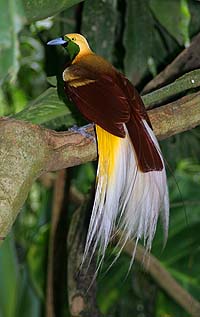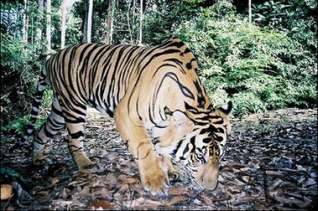Indonesia has 4 National parks are included in world heritage recognized by UNESCO, the UN agency of the world.
Indonesia's tropical forest area is the world's third largest forest after Brazil and the Democratic Republic of Congo. Tropical forests are home and the last hideout for the world's unique biological riches.
Indonesia's tropical forest extent of 98 million hectares (estimates of forest area in 2000). The data contained in the book Portrait of Indonesian Forest Condition, FWI / GFW, 2001, Bogor, Indonesia, the existing biodiversity in Indonesia's forests cover 11% of the world's plant species, 10% of species of mammals, and 16% of bird species. Around 17,000 islands of Indonesia has seven major biogeographic regions and diversity of habitat types extraordinary.
1. Komodo National Park
Komodo National Park consists of three large islands of Komodo, Rinca and Padar island as well as 26 large islands / other small. A total of 11 pieces of the mountain / hill in the Park with the highest peak is Mount Satalibo (± 735 meters above sea level). This national park land Area 603 km ² and the total area is 1817 km ².
Natural state of the dry and arid make a uniqueness. The existence of vast savannas, water resources are limited and temperatures hot enough, it turns out to be the habitat favored by a kind of ancient animals Komodo dragon (Varanus komodoensis).
Much of this national park is savanna with palm trees (Borassus flabellifer) the most dominant and distinctive. Some plants that exist in the Park, among others, rattan (Calamus sp.), bamboo (Bambusa sp.), acid (Tamarindus indica), bulging (Sterculia foetida), lote (Ziziphus jujuba), and mangrove (Rhizophora sp.)
In addition to the typical wildlife of Komodo, there are deer (Cervus timorensis floresiensis), wild boar (Sus scrofa), ajag (Cuon alpinus javanicus), wild horse (Equus qaballus), wild buffalo (Bubalus bubalis), 2 species of sea turtles, 10 species of dolphins , 6 species of whales and dugongs are often seen in marine waters of Komodo National Park
2. Ujung Kulon National Park
Ujung Kulon National Park is representative of tropical rain forest ecosystem remaining lowland and the largest in West Java, and is an ideal habitat for the survival of endangered Javan rhinoceros (Rhinoceros sondaicus) and other rare animals. There are three types of ecosystems in national parks is the aquatic ecosystem of the sea, marsh ecosystems, and terrestrial ecosystems.
Diversity of plants and animals in Ujung Kulon National Park began to be known by the investigators, the Dutch and British botanists since 1820. Approximately 700 types of plants is well protected and 57 of them rare species such as merbau (Intsia bijuga), palahlar (Dipterocarpus haseltii), bungur (Lagerstroemia speciosa), luminous (Pterospermum diversifolium), ki rain (Engelhardia serrata) and various types of orchids .
Wildlife in Ujung Kulon National Park consists of 35 species of mammals, 5 species of primates, 59 species of reptiles, 22 species of amphibian, 240 species of birds, 72 species of insects, 142 species of fish and 33 species of coral reefs. Endangered and protected animals other than Java rhinoceros is the banteng (Bos javanicus javanicus), ajag (Cuon alpinus javanicus), surili (Presbytis Comata Comata), langur (Trachypithecus auratus auratus), deer (Cervus timorensis Russa), leopard (Panthera pardus), stone cat (Prionailurus bengalensis javanensis), gibbons (Hylobates moloch), and giant clams (Tridacna gigas).
3. Lorentz National Park
Lorentz National Park is representative of the complete ecosystem for biodiversity in Southeast Asia and the Pacific. This area is also one among the three regions of the world that have a glacier in the tropics. Stretching from the snow-covered mountain peak (5030 meters above sea level), to stretch out to the coastal waters with mangrove forests and borders the Arafura Sea. In this stretch, there is a spectrum of ecological stunning alpine vegetation of the region, sub-alpine, montane, sub-montane, lowland, and wetland
The types of vegetation in this park include Nipah (Nypa fruticans), mangrove (Rhizophora apiculata), Pandanus julianettii, Colocasia esculenta, Avicennia marina, Podocarpus pilgeri, and Nauclea coadunata.
The types of animals that have been identified in the Lorentz National Park, as many as 630 species of birds (± 70% of the bird in Papua) and 123 species of mammals. Bird species characteristic of this national park there are two types of cassowary, four megapoda, 31 types of pigeon / doves, 30 species of parrots, 13 species of birds of shrimp, 29 species of birds honey, and 20 endemic species such as long-tailed bird of paradise (Paradigalla caruneulata) and Quail snow (Anurophasis monorthonyx).
Animals carrying mammals including pig snout long spines (Zaglossus bruijnii), pig snout short spines (Tachyglossus aculeatus), 4 types of possum, wallaby, wild cats, and tree kangaroos.
4. Tropical Rainforest of Sumatra
Sumatran rain forest
Tropical rain forests of Sumatra are home to various living creatures. Many of them are endangered species, such as the Sumatran orangutan, Sumatran tiger, Sumatran rabbit, and Sumatran rhinoceros. In tropical rain forests also grow a variety of endemic plants, such as bags semar, the world's largest flower Rafflesia and Amorphophallus highest interest.
Source
http://www.kaskus.us/showthread.php?t=7798089
Monday, April 11, 2011
KUSENG TagCloud
Healthy
(32)
Self Development
(27)
Legend
(18)
Think
(17)
Knowledge
(16)
Men
(16)
Amazing
(15)
Education
(14)
International
(14)
Women
(14)
Reality
(10)
Funny
(8)
Sex
(8)
Love
(7)
Mad
(6)
Mystery
(6)
Sport
(6)
Children
(5)
Nationality
(5)
Transportation
(5)
Advice
(4)
Foods
(4)
Nature
(4)
Secret
(4)
Culture
(3)
Games
(3)
Leadership
(3)
Movies
(3)
Music
(3)
Works
(3)
Animal
(2)
Marketing
(2)
Technology
(2)
 :.
:.






0 comments:
Post a Comment